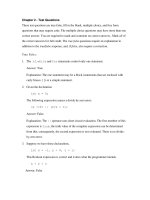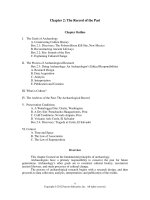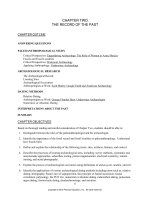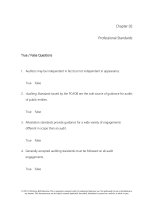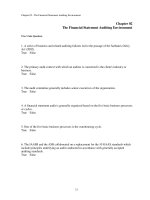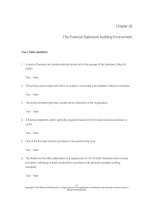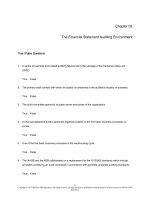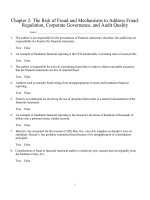Medical terminology a living language 5th edition fremgen test bank
Bạn đang xem bản rút gọn của tài liệu. Xem và tải ngay bản đầy đủ của tài liệu tại đây (348.32 KB, 47 trang )
Medical Terminology: A Living Language, 5e (Fremgen/Frucht)
Chapter 2 Body Organization
Fill-in-the-Blank
Write the word or phrase that best completes each statement or answers the question.
All answers to questions asking for a combining form must be written in the combining form
style, meaning word root/combining vowel. For example, the combining form meaning heart is
cardi/o. All answers to questions asking for a suffix must be written in suffix form, meaning a
hyphen before your answer. For example, the suffix meaning cell is -cyte. All answers to
questions asking for a prefix must be written in prefix form, meaning a hyphen after your
answer. For example, the prefix meaning two is bi-.
DO NOT capitalize any of your answers or include a period at the end of your answer. The
computer will NOT recognize your answer as correct if it is written in any other style.
1) The combining form that means abdomen is ____________________.
Answer: abdomin/o
Page Ref: 22
Learning Obj.: 1
Taxonomy: Knowledge
Question Type: Word Building
2) The combining form that means fat is ____________________.
Answer: adip/o
Page Ref: 22
Learning Obj.: 1
Taxonomy: Knowledge
Question Type: Word Building
3) The combining form that means head is ____________________.
Answer: cephal/o
Page Ref: 22
Learning Obj.: 1
Taxonomy: Knowledge
Question Type: Word Building
4) The combining form that means skull is ____________________.
Answer: crani/o
Page Ref: 22
Learning Obj.: 1
Taxonomy: Knowledge
Question Type: Word Building
1
Copyright © 2013 Pearson Education, Inc.
5) The combining form that means tail is ____________________.
Answer: caud/o
Page Ref: 22
Learning Obj.: 1
Taxonomy: Knowledge
Question Type: Word Building
6) The combining form that means leg is ____________________.
Answer: crur/o
Page Ref: 22
Learning Obj.: 1
Taxonomy: Knowledge
Question Type: Word Building
7) The combining form that means buttock is ____________________.
Answer: glute/o
Page Ref: 22
Learning Obj.: 1
Taxonomy: Knowledge
Question Type: Word Building
8) The combining form that means arm is ____________________.
Answer: brachi/o
Page Ref: 22
Learning Obj.: 1
Taxonomy: Knowledge
Question Type: Word Building
9) A combining form that means tissue is ____________________.
Answer: hist/o
Page Ref: 22
Learning Obj.: 1
Taxonomy: Knowledge
Question Type: Word Building
10) The combining form that means side is ____________________.
Answer: later/o
Page Ref: 22
Learning Obj.: 1
Taxonomy: Knowledge
Question Type: Word Building
2
Copyright © 2013 Pearson Education, Inc.
11) The combining form that means middle is ____________________.
Answer: medi/o
Page Ref: 22
Learning Obj.: 1
Taxonomy: Knowledge
Question Type: Word Building
12) The combining form that means internal organ is ____________________.
Answer: viscer/o
Page Ref: 22
Learning Obj.: 1
Taxonomy: Knowledge
Question Type: Word Building
13) A combining form that means chest is ____________________.
Answer: thorac/o
Page Ref: 22
Learning Obj.: 1
Taxonomy: Knowledge
Question Type: Word Building
14) The combining form that means stomach is ____________________.
Answer: gastr/o
Page Ref: 22
Learning Obj.: 1
Taxonomy: Knowledge
Question Type: Word Building
15) The combining form that means spine is ____________________.
Answer: spin/o
Page Ref: 22
Learning Obj.: 1
Taxonomy: Knowledge
Question Type: Word Building
16) The combining form that means pelvis is ____________________.
Answer: pelv/o
Page Ref: 22
Learning Obj.: 1
Taxonomy: Knowledge
Question Type: Word Building
3
Copyright © 2013 Pearson Education, Inc.
17) The combining form that means to secrete is ____________________.
Answer: crin/o
Page Ref: 22
Learning Obj.: 1
Taxonomy: Knowledge
Question Type: Word Building
18) The combining form that means muscles is ____________________.
Answer: muscul/o
Page Ref: 22
Learning Obj.: 1
Taxonomy: Knowledge
Question Type: Word Building
19) The combining form that means peritoneum is ____________________.
Answer: peritone/o
Page Ref: 22
Learning Obj.: 1
Taxonomy: Knowledge
Question Type: Word Building
20) The combining form that means genital region is ____________________.
Answer: pub/o
Page Ref: 22
Learning Obj.: 1
Taxonomy: Knowledge
Question Type: Word Building
21) The combining form that means woman is ____________________.
Answer: gynec/o
Page Ref: 22
Learning Obj.: 1
Taxonomy: Knowledge
Question Type: Word Building
22) The combining form that means neck is ____________________.
Answer: cervic/o
Page Ref: 22
Learning Obj.: 1
Taxonomy: Knowledge
Question Type: Word Building
4
Copyright © 2013 Pearson Education, Inc.
23) The combining form that means cartilage is____________________.
Answer: chondr/o
Page Ref: 22
Learning Obj.: 1
Taxonomy: Knowledge
Question Type: Word Building
24) The combining form that means pleura is ____________________.
Answer: pleur/o
Page Ref: 22
Learning Obj.: 1
Taxonomy: Knowledge
Question Type: Word Building
25) The combining form that means vertebra is ____________________.
Answer: vertebr/o
Page Ref: 22
Learning Obj.: 1
Taxonomy: Knowledge
Question Type: Word Building
26) A medical term that means pertaining to the abdomen is ____________________.
Answer: abdominal
Page Ref: 39
Learning Obj.: 2
Taxonomy: Comprehension
Question Type: Body Positions
27) A medical term that means pertaining to the front is ____________________.
Answer: anterior
Page Ref: 39
Learning Obj.: 10
Taxonomy: Comprehension
Question Type: Body Positions
28) A medical term that means pertaining to the arm is ____________________.
Answer: brachial
Page Ref: 39
Learning Obj.: 2
Taxonomy: Comprehension
Question Type: Body Positions
5
Copyright © 2013 Pearson Education, Inc.
29) A medical term that means pertaining to the head is ____________________.
Answer: cephalic
Page Ref: 39
Learning Obj.: 2
Taxonomy: Comprehension
Question Type: Body Positions
30) A medical term that means pertaining to the neck is ____________________.
Answer: cervical
Page Ref: 39
Learning Obj.: 2
Taxonomy: Comprehension
Question Type: Body Positions
31) A medical term that means pertaining to the skull is ____________________.
Answer: cranial
Page Ref: 39
Learning Obj.: 2
Taxonomy: Comprehension
Question Type: Body Positions
32) A medical term that means pertaining to the leg is ____________________.
Answer: crural
Page Ref: 39
Learning Obj.: 2
Taxonomy: Comprehension
Question Type: Body Positions
33) A medical term that means pertaining to the buttocks is ____________________.
Answer: gluteal
Page Ref: 40
Learning Obj.: 2
Taxonomy: Comprehension
Question Type: Body Positions
34) A medical term that means pertaining to the side is ____________________.
Answer: lateral
Page Ref: 40
Learning Obj.: 10
Taxonomy: Comprehension
Question Type: Body Positions
6
Copyright © 2013 Pearson Education, Inc.
35) A medical term that means pertaining to the middle is ____________________.
Answer: medial
Page Ref: 40
Learning Obj.: 10
Taxonomy: Comprehension
Question Type: Body Positions
36) A medical term that means pertaining to muscles is ____________________.
Answer: muscular
Page Ref: 40
Learning Obj.: 2
Taxonomy: Comprehension
Question Type: Body Positions
37) A medical term that means pertaining to the heart and blood vessels is
____________________.
Answer: cardiovascular
Page Ref: 39
Learning Obj.: 2
Taxonomy: Comprehension
Question Type: Anatomy and Physiology
38) A medical term that means pertaining to blood is ____________________.
Answer: hematic
Page Ref: 40
Learning Obj.: 2
Taxonomy: Comprehension
Question Type: Anatomy and Physiology
39) A medical term that means pertaining to the pelvis is ____________________.
Answer: pelvic
Page Ref: 40
Learning Obj.: 2
Taxonomy: Comprehension
Question Type: Anatomy and Physiology
40) A medical term that means pertaining to the peritoneum is ____________________.
Answer: peritoneal
Page Ref: 40
Learning Obj.: 2
Taxonomy: Comprehension
Question Type: Anatomy and Physiology
7
Copyright © 2013 Pearson Education, Inc.
41) A medical term that means pertaining to the pleura is ____________________.
Answer: pleural
Page Ref: 41
Learning Obj.: 2
Taxonomy: Comprehension
Question Type: Anatomy and Physiology
42) A medical term that means pertaining to the genital region is ____________________.
Answer: pubic
Page Ref: 41
Learning Obj.: 2
Taxonomy: Comprehension
Question Type: Anatomy and Physiology
43) A medical term that means pertaining to lymph is ____________________.
Answer: lymphatic
Page Ref: 40
Learning Obj.: 2
Taxonomy: Comprehension
Question Type: Anatomy and Physiology
44) A medical term that means pertaining to the spine is ____________________.
Answer: spinal
Page Ref: 41
Learning Obj.: 2
Taxonomy: Comprehension
Question Type: Anatomy and Physiology
45) A medical term that means pertaining to above is ____________________.
Answer: superior
Page Ref: 41
Learning Obj.: 2
Taxonomy: Comprehension
Question Type: Anatomy and Physiology
46) A medical term that means pertaining to the chest is ____________________.
Answer: thoracic
Page Ref: 41
Learning Obj.: 2
Taxonomy: Comprehension
Question Type: Anatomy and Physiology
8
Copyright © 2013 Pearson Education, Inc.
47) A medical term that means pertaining to the vertebrae is ____________________.
Answer: vertebral
Page Ref: 41
Learning Obj.: 2
Taxonomy: Comprehension
Question Type: Anatomy and Physiology
48) A medical term that means pertaining to internal organs is ____________________.
Answer: visceral
Page Ref: 41
Learning Obj.: 2
Taxonomy: Comprehension
Question Type: Anatomy and Physiology
49) A medical term that means pertaining to the epithelium is ____________________.
Answer: epithelial
Page Ref: 39
Learning Obj.: 2
Taxonomy: Comprehension
Question Type: Anatomy and Physiology
50) A medical term that means pertaining to the belly side of the body is ___________________.
Answer: ventral
Page Ref: 41
Learning Obj.: 10
Taxonomy: Comprehension
Question Type: Body Positions
True/False
1) The correct order for the organization of the body is cell to tissue to organ to system to whole
body.
Answer: TRUE
Page Ref: 24
Learning Obj.: 3
Taxonomy: Knowledge
Question Type: Anatomy and Physiology
2) All cells have a cell membrane.
Answer: TRUE
Page Ref: 24
Learning Obj.: 4
Taxonomy: Knowledge
Question Type: Anatomy and Physiology
9
Copyright © 2013 Pearson Education, Inc.
3) Adipose is a type of connective tissue.
Answer: TRUE
Page Ref: 25
Learning Obj.: 5
Taxonomy: Knowledge
Question Type: Anatomy and Physiology
4) Nervous tissue is designed to produce body movement.
Answer: FALSE
Explanation: Muscular tissue is designed to produce body movement; nervous tissue is designed
to conduct electrical impulses.
Page Ref: 25
Learning Obj.: 5
Taxonomy: Knowledge
Question Type: Anatomy and Physiology
5) Bone and cartilage are types of nervous tissue.
Answer: FALSE
Explanation: Bone and cartilage are types of connective tissue.
Page Ref: 25
Learning Obj.: 5
Taxonomy: Knowledge
Question Type: Anatomy and Physiology
6) The brain is found in the integumentary system.
Answer: FALSE
Explanation: The brain is found in the nervous system.
Page Ref: 27
Learning Obj.: 6
Taxonomy: Knowledge
Question Type: Anatomy and Physiology
7) The kidneys are part of the hematic system.
Answer: FALSE
Explanation: The kidneys are part of the urinary system.
Page Ref: 28
Learning Obj.: 6
Taxonomy: Knowledge
Question Type: Anatomy and Physiology
8) The pancreas is part of both the digestive and endocrine systems.
Answer: TRUE
Page Ref: 29, 30
Learning Obj.: 6
Taxonomy: Knowledge
Question Type: Anatomy and Physiology
10
Copyright © 2013 Pearson Education, Inc.
9) The special senses include the eye and ear.
Answer: TRUE
Page Ref: 31
Learning Obj.: 6
Taxonomy: Knowledge
Question Type: Anatomy and Physiology
10) Gynecology is the branch of medicine that treats the male reproductive tract.
Answer: FALSE
Explanation: Gynecology is the branch of medicine that treats the female reproductive tract.
Urology is the branch of medicine that treats the male reproductive tract.
Page Ref: 30
Learning Obj.: 6
Taxonomy: Knowledge
Question Type: Specialties and Specialists
11) The study of tissues is called cytology.
Answer: FALSE
Explanation: The study of tissues is called histology. The study of cells is called cytology.
Page Ref: 39
Learning Obj.: 6
Taxonomy: Knowledge
Question Type: Specialties and Specialists
12) Pulmonology is the branch of medicine that treats the respiratory system.
Answer: TRUE
Page Ref: 41
Learning Obj.: 6
Taxonomy: Knowledge
Question Type: Specialties and Specialists
13) When describing body position, the assumption is always that the person is in the anatomical
position.
Answer: TRUE
Page Ref: 31
Learning Obj.: 7
Taxonomy: Knowledge
Question Type: Body Positions
14) In the anatomical position the body is lying on its back.
Answer: FALSE
Explanation: In the anatomical position, the body is standing erect.
Page Ref: 31
Learning Obj.: 7
Taxonomy: Knowledge
Question Type: Body Positions
11
Copyright © 2013 Pearson Education, Inc.
15) The sagittal plane is also called the coronal plane.
Answer: FALSE
Explanation: The frontal plane is also called the coronal plane.
Page Ref: 32
Learning Obj.: 8
Taxonomy: Knowledge
Question Type: Body Positions
16) The transverse plane is a horizontal plane.
Answer: TRUE
Page Ref: 33
Learning Obj.: 8
Taxonomy: Knowledge
Question Type: Body Positions
17) The sagittal plane divides the body into left and right portions.
Answer: TRUE
Page Ref: 32
Learning Obj.: 8
Taxonomy: Knowledge
Question Type: Body Positions
18) The coronal plane divides the body into upper and lower portions.
Answer: FALSE
Explanation: The coronal plane divides the body into front and back portions. The transverse
plane divides the body into upper and lower portions.
Page Ref: 33
Learning Obj.: 8
Taxonomy: Knowledge
Question Type: Body Positions
19) A longitudinal section of the body is produced by a lengthwise slice along the long axis of a
structure.
Answer: TRUE
Page Ref: 33
Learning Obj.: 8
Taxonomy: Knowledge
Question Type: Body Positions
20) The dorsum is found on the posterior side of the trunk.
Answer: TRUE
Page Ref: 33
Learning Obj.: 9
Taxonomy: Knowledge
Question Type: Body Positions
12
Copyright © 2013 Pearson Education, Inc.
21) The lower extremities are the brachial region of the body.
Answer: FALSE
Explanation: The lower extremities are the crural region of the body. The upper extremities are
the brachial region of the body.
Page Ref: 33
Learning Obj.: 9
Taxonomy: Knowledge
Question Type: Body Positions
22) The pubic region is the genital area of the body.
Answer: TRUE
Page Ref: 33
Learning Obj.: 9
Taxonomy: Knowledge
Question Type: Body Positions
23) The buttocks are the crural region of the body.
Answer: FALSE
Explanation: The buttocks are the gluteal region of the body. The legs are the crural region of
the body.
Page Ref: 33
Learning Obj.: 9
Taxonomy: Knowledge
Question Type: Body Positions
24) The diaphragm divides the thoracic cavity from the abdominopelvic cavity.
Answer: TRUE
Page Ref: 34
Learning Obj.: 11
Taxonomy: Knowledge
Question Type: Body Positions
25) The mediastinum is located in the center of the abdominal cavity.
Answer: FALSE
Explanation: The mediastinum is located in the center of the thoracic cavity.
Page Ref: 34
Learning Obj.: 11
Taxonomy: Knowledge
Question Type: Anatomy and Physiology
26) The pleural cavity contains the heart.
Answer: FALSE
Explanation: The pleural cavity contains the lungs. The pericardial cavity contains the heart.
Page Ref: 35
Learning Obj.: 11
Taxonomy: Knowledge
Question Type: Anatomy and Physiology
13
Copyright © 2013 Pearson Education, Inc.
27) The hypochondriac region is located beneath the lower ribs.
Answer: TRUE
Page Ref: 36
Learning Obj.: 12
Taxonomy: Knowledge
Question Type: Body Positions
28) The umbilical region centers over the navel.
Answer: TRUE
Page Ref: 36
Learning Obj.: 12
Taxonomy: Knowledge
Question Type: Body Positions
29) The lumbar region is in the groin.
Answer: FALSE
Explanation: The lumbar regions are located on the right and left side of the umbilical region.
The iliac regions are located in the groin.
Page Ref: 36
Learning Obj.: 12
Taxonomy: Knowledge
Question Type: Body Positions
30) The right upper quadrant contains the gallbladder.
Answer: TRUE
Page Ref: 36
Learning Obj.: 12
Taxonomy: Knowledge
Question Type: Body Positions
31) The left lower quadrant contains the appendix.
Answer: FALSE
Explanation: The right lower quadrant contains the appendix.
Page Ref: 36
Learning Obj.: 12
Taxonomy: Knowledge
Question Type: Body Positions
32) The respiratory system obtains oxygen and removes carbon dioxide from the body.
Answer: TRUE
Page Ref: 29
Learning Obj.: 5
Taxonomy: Knowledge
Question Type: Anatomy and Physiology
14
Copyright © 2013 Pearson Education, Inc.
33) The female reproductive system produces sperm for reproduction.
Answer: FALSE
Explanation: The female reproductive system produces ova for reproduction. The male
reproductive system produces sperm for reproduction.
Page Ref: 30
Learning Obj.: 5
Taxonomy: Knowledge
Question Type: Anatomy and Physiology
34) The urinary system filters waste products from the blood.
Answer: TRUE
Page Ref: 29
Learning Obj.: 5
Taxonomy: Knowledge
Question Type: Anatomy and Physiology
35) The cardiovascular system protects the body from disease and invasion from pathogens.
Answer: FALSE
Explanation: The immune system protects the body from disease and invasion from pathogens.
Page Ref: 28
Learning Obj.: 5
Taxonomy: Knowledge
Question Type: Anatomy and Physiology
36) The term superior is interchangeable with cephalic.
Answer: TRUE
Page Ref: 37
Learning Obj.: 10
Taxonomy: Knowledge
Question Type: Body Positions
37) The term inferior is interchangeable with dorsal.
Answer: FALSE
Explanation: The term inferior is interchangeable with caudal. The term posterior is
interchangeable with dorsal.
Page Ref: 37
Learning Obj.: 10
Taxonomy: Knowledge
Question Type: Body Positions
38) The term deep means farther away from the surface of the body.
Answer: TRUE
Page Ref: 37
Learning Obj.: 10
Taxonomy: Knowledge
Question Type: Body Positions
15
Copyright © 2013 Pearson Education, Inc.
39) The term apex refers to the bottom or lower part of an organ.
Answer: FALSE
Explanation: The term apex refers to the tip or summit of an organ. The term base refers to the
bottom or lower part of an organ.
Page Ref: 37
Learning Obj.: 10
Taxonomy: Knowledge
Question Type: Body Positions
40) The term prone means lying face downward.
Answer: TRUE
Page Ref: 38
Learning Obj.: 10
Taxonomy: Knowledge
Question Type: Body Positions
41) The term medial refers to the side.
Answer: FALSE
Explanation: The term lateral refers to the side. The term medial refers to the middle.
Page Ref: 40
Learning Obj.: 10
Taxonomy: Knowledge
Question Type: Body Positions
42) The direction term anterior means pertaining to the front.
Answer: TRUE
Page Ref: 39
Learning Obj.: 10
Taxonomy: Knowledge
Question Type: Body Positions
43) The term cranial means pertaining to the head.
Answer: FALSE
Explanation: The term cranial means pertaining to the skull. The term cephalic means
pertaining to the head.
Page Ref: 39
Learning Obj.: 2
Taxonomy: Knowledge
Question Type: Body Positions
44) The term gluteal means pertaining to the pubic region.
Answer: FALSE
Explanation: The term gluteal means pertaining to the buttocks.
Page Ref: 40
Learning Obj.: 9
Taxonomy: Knowledge
Question Type: Anatomy and Physiology
16
Copyright © 2013 Pearson Education, Inc.
45) The term brachial means pertaining to the arm.
Answer: TRUE
Page Ref: 39
Learning Obj.: 2
Taxonomy: Knowledge
Question Type: Anatomy and Physiology
46) The term dermatology means the study of the skin.
Answer: TRUE
Page Ref: 39
Learning Obj.: 2
Taxonomy: Knowledge
Question Type: Anatomy and Physiology
47) The term visceral means pertaining to the belly-side of the body.
Answer: FALSE
Explanation: The term ventral means pertaining to the belly-side of the body. The term visceral
means pertaining to the viscera.
Page Ref: 41
Learning Obj.: 11
Taxonomy: Knowledge
Question Type: Anatomy and Physiology
48) The term thoracic means pertaining to the chest.
Answer: TRUE
Page Ref: 41
Learning Obj.: 2
Taxonomy: Knowledge
Question Type: Anatomy and Physiology
49) The abbreviation GI stands for the urinary system.
Answer: FALSE
Explanation: The abbreviation GI stands for the gastrointestinal (digestive) system.
Page Ref: 41
Learning Obj.: 14
Taxonomy: Knowledge
Question Type: Abbreviations
50) The abbreviation LE stands for the leg.
Answer: TRUE
Page Ref: 41
Learning Obj.: 14
Taxonomy: Knowledge
Question Type: Abbreviations
17
Copyright © 2013 Pearson Education, Inc.
Multiple-Choice
1) Which of the following is the correct order for the organization of the body?
A) cells to tissue to system to organ to whole body
B) cells to organ to system to tissue to whole body
C) cells to tissue to organ to system to whole body
D) tissue to cells to organ to system to whole body
Answer: C
Explanation: C) The correct order for the organization of the body is cells to tissue to organ to
system to whole body. All other answers are incorrect.
Page Ref: 24
Learning Obj.: 3
Taxonomy: Knowledge
Question Type: Anatomy and Physiology
2) Organs come together to form ________.
A) systems
B) cells
C) tissue
D) whole body
Answer: A
Explanation: A) Organs come together to form systems. Cells come together to make tissue.
Tissue comes together to make organs. The whole body is formed by systems.
Page Ref: 24
Learning Obj.: 3
Taxonomy: Knowledge
Question Type: Anatomy and Physiology
3) Which of the following is NOT a structure that is found in all cells?
A) cell membrane
B) epithelium
C) cytoplasm
D) nucleus
Answer: B
Explanation: B) All cells have a cell membrane, cytoplasm, and nucleus. Epithelium is a type of
tissue.
Page Ref: 24
Learning Obj.: 4
Taxonomy: Knowledge
Question Type: Anatomy and Physiology
18
Copyright © 2013 Pearson Education, Inc.
4) Which of the following is NOT one of the basic types of tissue found in the body?
A) muscular
B) connective
C) histogenic
D) epithelial
Answer: C
Explanation: C) Muscular, connective, epithelial, and nervous tissues are the four basic types of
tissue found in the body. Histogenic is a medical term meaning tissue producing.
Page Ref: 25
Learning Obj.: 5
Taxonomy: Knowledge
Question Type: Anatomy and Physiology
5) Which is NOT a function of epithelial tissue?
A) support body structures
B) protective barrier
C) absorb substances
D) secrete substances
Answer: A
Explanation: A) Supporting body structures is a function of connective tissue. The other choices
are functions of epithelial tissue.
Page Ref: 25
Learning Obj.: 5
Taxonomy: Knowledge
Question Type: Anatomy and Physiology
6) Which type of tissue is designed to conduct electrical impulses?
A) muscular
B) connective
C) epithelial
D) nervous
Answer: D
Explanation: D) Muscular tissue produces body movement. Nervous tissue is designed to
conduct electrical impulses. Connective tissue supports and protects body structures. Epithelial
tissue forms a protective barrier, absorbs and secretes substances, and excretes waste.
Page Ref: 25
Learning Obj.: 5
Taxonomy: Knowledge
Question Type: Anatomy and Physiology
19
Copyright © 2013 Pearson Education, Inc.
7) Which type of tissue is designed to produce body movement?
A) muscle
B) connective
C) epithelial
D) nervous
Answer: A
Explanation: A) Muscular tissue is designed to produce body movement. Connective tissue
supports and protects body structures. Epithelial tissue forms a protective barrier, absorbs and
secretes substances, and excretes waste. Nervous tissue is designed to conduct electrical
impulses.
Page Ref: 25
Learning Obj.: 5
Taxonomy: Knowledge
Question Type: Anatomy and Physiology
8) Which type of muscle tissue is found attached to bone?
A) smooth
B) visceral
C) skeletal
D) cardiac
Answer: C
Explanation: C) Skeletal muscle tissue is found attached to the bone. Smooth muscle tissue is
found in the internal organs. Visceral means pertaining to internal organs. Cardiac muscle tissue
is found in the heart.
Page Ref: 25
Learning Obj.: 5
Taxonomy: Knowledge
Question Type: Anatomy and Physiology
9) Which is NOT an organ found in the digestive system?
A) spleen
B) stomach
C) liver
D) colon
Answer: A
Explanation: A) The spleen is found in the immune system. The stomach, liver, and colon are
found in the digestive system.
Page Ref: 29
Learning Obj.: 6
Taxonomy: Knowledge
Question Type: Anatomy and Physiology
20
Copyright © 2013 Pearson Education, Inc.
10) The hematic system is commonly called:
A) urinary
B) blood
C) immune
D) cardiovascular
Answer: B
Explanation: B) The hematic system is commonly known as blood. The urinary system is
sometimes called genitourinary. The immune system is sometimes called the lymphatic system.
The cardiovascular system is sometimes called the circulatory system.
Page Ref: 28
Learning Obj.: 6
Taxonomy: Knowledge
Question Type: Anatomy and Physiology
11) The thyroid, thymus, and adrenal glands are found in the:
A) muscular system
B) nervous system
C) endocrine system
D) male reproductive system
Answer: C
Explanation: C) The thyroid, thymus, and adrenal glands are found in the endocrine system. The
muscular system contains the muscles. The nervous system contains the brain, spinal cord, and
nerves. The male reproductive system contains the testes, epididymis, vas deferens, penis,
seminal vesicles, prostate gland, and bulbourethral gland.
Page Ref: 30
Learning Obj.: 6
Taxonomy: Knowledge
Question Type: Anatomy and Physiology
12) Which branch of medicine treats conditions of the eye?
A) obstetrics
B) endocrinology
C) otorhinolaryngology
D) ophthalmology
Answer: D
Explanation: D) Ophthalmology is the branch of medicine that treats conditions of the eye.
Obstetrics is the branch of medicine dealing with pregnancy and childbirth. Endocrinology treats
the endocrine system. Otorhinolaryngology involves treating the ears, nose, and throat.
Page Ref: 31
Learning Obj.: 6
Taxonomy: Knowledge
Question Type: Specialties and Specialists
21
Copyright © 2013 Pearson Education, Inc.
13) A gastroenterologist would treat diseases of which of the following organs?
A) brain
B) stomach
C) tonsils
D) heart
Answer: B
Explanation: B) A gastroenterologist treats diseases of organs located in the digestive system. A
neurologist would treat diseases of the brain. An otorhinolaryngologist treats diseases of the
tonsils. A cardiologist would treat diseases of the heart.
Page Ref: 40
Learning Obj.: 6
Taxonomy: Comprehension
Question Type: Specialties and Specialists
14) Which of the following is NOT part of the anatomical position?
A) standing erect
B) palms facing backward
C) feet together
D) fingers extended
Answer: B
Explanation: B) Palms facing forward is part of the anatomical position, not palms facing
backward. Standing erect, feet together, and fingers extended are all part of the anatomical
position.
Page Ref: 31
Learning Obj.: 7
Taxonomy: Knowledge
Question Type: Body Positions
15) Which plane divides the body into left and right portions?
A) sagittal
B) frontal
C) coronal
D) transverse
Answer: A
Explanation: A) The sagittal plan divides the body into left and right portions. The frontal or
coronal plane divides the body into front and back portions. The transverse plane divides the
body into upper and lower portions.
Page Ref: 32
Learning Obj.: 8
Taxonomy: Knowledge
Question Type: Body Positions
22
Copyright © 2013 Pearson Education, Inc.
16) Which plane divides the body into front and back portions?
A) sagittal
B) frontal
C) transverse
D) median
Answer: B
Explanation: B) The frontal or coronal plane divides the body into front and back portions. The
sagittal or median plane divides the body into left and right portions. The transverse plane
divides the body into upper and lower portions.
Page Ref: 33
Learning Obj.: 8
Taxonomy: Knowledge
Question Type: Body Positions
17) Which plane is the only horizontal plane?
A) sagittal
B) frontal
C) transverse
D) median
Answer: C
Explanation: C) The transverse plane is the only horizontal plane. The sagittal, frontal, and
median planes are all vertical planes.
Page Ref: 33
Learning Obj.: 8
Taxonomy: Knowledge
Question Type: Body Positions
18) Which sectional view of the body is produced by a slice perpendicular to the long axis?
A) cross-section
B) transverse section
C) longitudinal section
D) sagittal section
Answer: A
Explanation: A) A cross-section is a horizontal section of the body and, therefore, perpendicular
to the long axis of the body. Transverse, longitudinal, and sagittal sections are vertical sections
and would be parallel to the long axis.
Page Ref: 33
Learning Obj.: 8
Taxonomy: Comprehension
Question Type: Body Positions
23
Copyright © 2013 Pearson Education, Inc.
19) The neck is the ________ region of the body.
A) dorsal
B) cervical
C) cephalic
D) pubic
Answer: B
Explanation: B) The neck is the cervical region of the body. The back is the dorsal region of the
body. The head is the cephalic region of the body. The genitals are the pubic region of the body.
Page Ref: 33
Learning Obj.: 9
Taxonomy: Knowledge
Question Type: Body Positions
20) The cephalic region of the body is the:
A) neck
B) back
C) head
D) buttocks
Answer: C
Explanation: C) The head is the cephalic region of the body. The neck is the cervical region of
the body. The back is the dorsal region of the body. The buttocks are the gluteal region of the
body.
Page Ref: 33
Learning Obj.: 9
Taxonomy: Knowledge
Question Type: Body Positions
21) The crural region of the body is the:
A) buttocks
B) arms
C) abdomen
D) legs
Answer: D
Explanation: D) The legs are the crural region of the body. The buttocks are the gluteal region of
the body. The arms are the brachial region of the body. The abdomen is the abdominal region of
the body.
Page Ref: 33
Learning Obj.: 9
Taxonomy: Knowledge
Question Type: Body Positions
24
Copyright © 2013 Pearson Education, Inc.
22) The arms are the ________ region of the body.
A) brachial
B) crural
C) trunk
D) pelvic
Answer: A
Explanation: A) The arms are the brachial region of the body. The legs are the crural region of
the body. The trunk contains several regions of the body. The pelvis is the pelvic region of the
body.
Page Ref: 33
Learning Obj.: 9
Taxonomy: Knowledge
Question Type: Body Positions
23) Which of the following is NOT one of the anterior regions of the trunk?
A) abdominal
B) dorsum
C) pelvic
D) pubic
Answer: B
Explanation: B) The dorsum is a posterior region of the trunk. The abdominal, pelvic, and pubic
regions are all anterior regions of the trunk.
Page Ref: 33
Learning Obj.: 9
Taxonomy: Knowledge
Question Type: Body Positions
24) Which of the following body cavities is a dorsal cavity?
A) abdominal
B) pelvic
C) thoracic
D) spinal
Answer: D
Explanation: D) The spinal cavity is a dorsal cavity. The abdominal, pelvic, and thoracic cavities
are all ventral cavities.
Page Ref: 34
Learning Obj.: 11
Taxonomy: Knowledge
Question Type: Body Positions
25
Copyright © 2013 Pearson Education, Inc.
